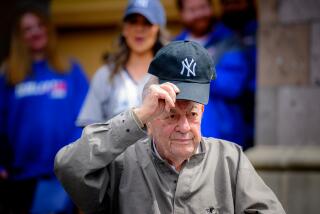“Spahn and Sain and pray for rain.”...
“Spahn and Sain and pray for rain.” -- A popular saying from the 1948 baseball season.
---
Johnny Sain, a three-time All-Star who teamed with Warren Spahn to make up one of baseball’s most fabled pitching tandems, has died. He was 89.
Sain, who was a highly successful pitching coach after his playing days ended, died Tuesday at a nursing home in Downers Grove, Ill. He had been in failing health after suffering a stroke in 2002.
Sain was the last man to pitch to Babe Ruth in an organized baseball game during a 1943 exhibition at Yankee Stadium and the first man to pitch to Jackie Robinson in a major league game after the Dodger broke baseball’s color barrier with Brooklyn in 1947.
His best year as a pitcher was 1948, when he and Spahn led the Boston Braves to the World Series, where they lost to the Cleveland Indians.
The popular saying -- “Spahn and Sain and pray for rain” -- came from a poem written by Boston Post sports editor Gerald Hern that reflected the state of Boston’s starting pitching.
Spahn and Sain were dominant -- especially during the pennant stretch -- and the rest of the rotation was unheralded.
“First we’ll use Spahn, then we’ll use Sain,
Then an off day, followed by rain.
Back will come Spahn, followed by Sain,
And followed, we hope, by two days of rain,” the poem read.
During the pennant drive, the right-handed Sain pitched nine complete games in 29 days, winning seven. He capped the streak by beating Bob Feller and the Indians, 1-0, in the first game of the World Series.
In his 11 major league seasons during the 1940s and ‘50s, Sain was 139-116 with a 3.49 earned-run average.
In addition to pitching for the Braves, he won three straight World Series titles with the New York Yankees from 1951 to 1953.
With the Yankees he excelled as a relief pitcher, leading the American League in saves with 22 in 1954.
Far from being a one-dimensional player, he also was a fine hitter, ending his career with a .245 average. He struck out only 20 times in 774 at-bats.
After his playing days, Sain was the pitching coach for the Yankees, Chicago White Sox, Detroit Tigers and Minnesota Twins.
Sain tutored 16 pitchers who won 20 or more games in a season, including Jim Kaat of the Twins and White Sox and Jim Bouton of the Yankees.
Sain was Denny McLain’s pitching coach when McLain won 31 games in 1968. McLain was the last major league pitcher to win 30 games in a season.
Kaat, who had two 20-win seasons with the White Sox with Sain as his pitching coach, credited Sain with rejuvenating his career after suggesting a no-windup delivery.
“He meant more to my career than anyone I know,” Kaat once told the Chicago Tribune. “Johnny Sain knew more about the touch, feel and mental side of pitching than anyone I encountered in my 50 years of professional baseball.
“If Johnny watched you warm up, he wouldn’t say things about your mechanics or your body or head position,” Kaat recalled.
“He would ask things like, ‘Show me how slow you can throw the ball and how big you can make it curve, then show me how hard you can throw the ball and how little you can make it curve.’ ”
In 1972, Sain told Thomas Boswell of the Washington Post that changing speeds was a key to pitching.
“People always talk about the pure stuff on a pitch or where the pitcher positions the ball, like low outside. But the other key is changing velocity, yet most managers are afraid of the change-up.”
Bouton said Sain influenced his life beyond baseball.
“He respected hard work without complaint. He’d say, ‘The world doesn’t want to hear about the labor pains, it just wants to see the baby.’ ”
Some of Sain’s theories were controversial, however.
He believed that as a training tool, throwing was far more important than running for pitchers. “You don’t run the ball up to home plate,” he once said.
To that end, he encouraged his pitchers to throw a little every day between starts and to throw throughout the off-season to keep their arms healthy.
The son of an auto mechanic, Sain was born in Havana, Ark.
After several years in the minor leagues, he came up to the Braves in 1942 but pitched only one season before joining the Navy Air Corps during World War II. He returned to Boston for the 1946 season.
He is survived by his wife, Mary Ann.
More to Read
Go beyond the scoreboard
Get the latest on L.A.'s teams in the daily Sports Report newsletter.
You may occasionally receive promotional content from the Los Angeles Times.










